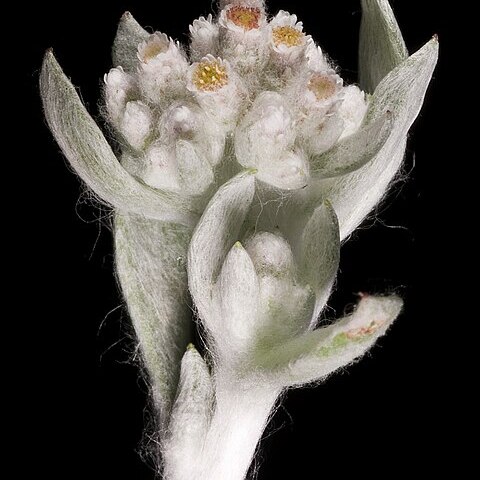Annual herb; stems densely white-tomentose, 1-many, ascending to erect, 10-50 cm tall. Lvs all cauline at flowering, apetiolate, densely white-tomentose on both surfaces but somewhat denser on lower, narrow-oblanceolate, cuneate, acute and mucronate, flat, 20-45-(60) × 3-6 mm; uppermost lvs smaller and sometimes elliptic-oblong. Capitula 1-2 mm diam., many to numerous in dense, mostly terminal, corymbose clusters; subtending lvs not exceeding clusters at least at fruiting. Middle involucral bracts tomentose outside, 2-2.5 mm long, star-like at fruiting; stereome narrow-oblong, green with upper margin usually purple; lamina ovate, obtuse, milky white, radiating; outer bracts shorter, with lamina reduced or O; inner bracts slightly longer, less hairy. Disc tinged yellow or purple. Achenes ellipsoid-cylindric, minutely papillate, c. 0.4 mm long.
Prostrate to weakly erect, white-woolly annual or perennial(?) herb, up to 0.45 m long. Leaves alternate, oblanceolate or narrowly spathulate, apex subacute to obtuse, base attenuate, petiole-like in lower leaves, margins entire, decreasing in size upwards, both surfaces white silky-woolly. Capitula disciform, crowded in dense, woolly, terminal corymbs; involucral bracts in 3 rows, apex of inner bracts oblong, obtuse, white, with purplish reddish blotch in center. Outer florets female, outnumbering the bisexual ones, narrowly tubular or filiform, yellow, tipped red-purple. Disc florets tubular, yellow, tipped red-purple. Flowering time Oct.-Feb. Pappus of bristles with subplumose apex. Cypselae oblong, hairy.
Burtt Sprawling, white-woolly annual or ?perennial herb, up to 300 mm tall. Leaves alternate, oblanceolate, decreasing in size upwards, apex subacute to obtuse. Flowerheads disciform, in dense woolly, terminal corymbs; tips of inner involucral bracts oblong, obtuse, white, with purplish red blotch in centre; female florets more than bisexual florets, yellow, tipped red-purple. Pappus bristles with subplumose tips.
Sprawling, white-woolly annual or ?perennial to 20 cm. Leaves oblanceolate. Flower heads discoid, crowded in dense, woolly, terminal corymbs, white, female flowers exceeding hermaphrodite ones; bracts reddish in centre.

